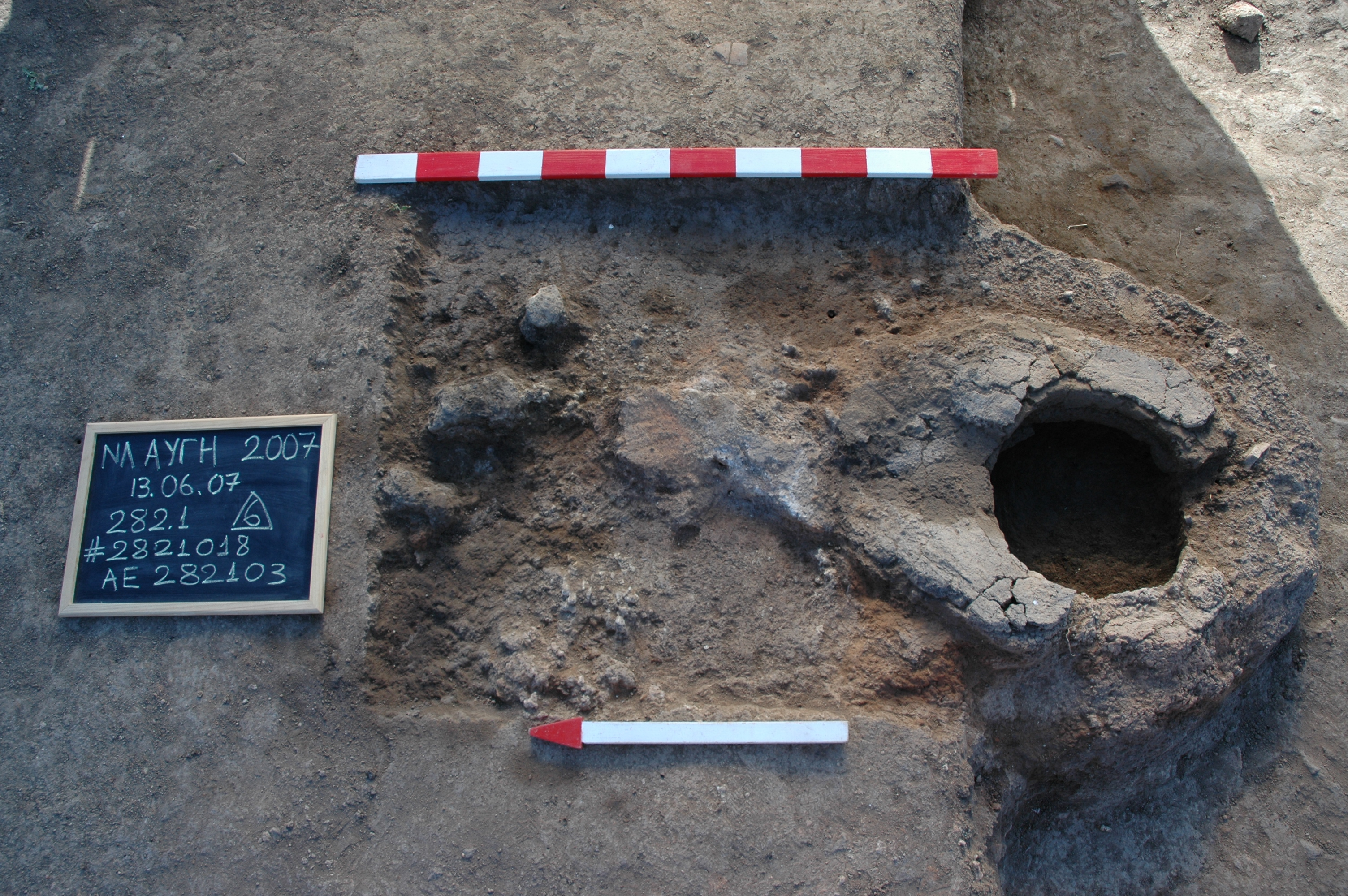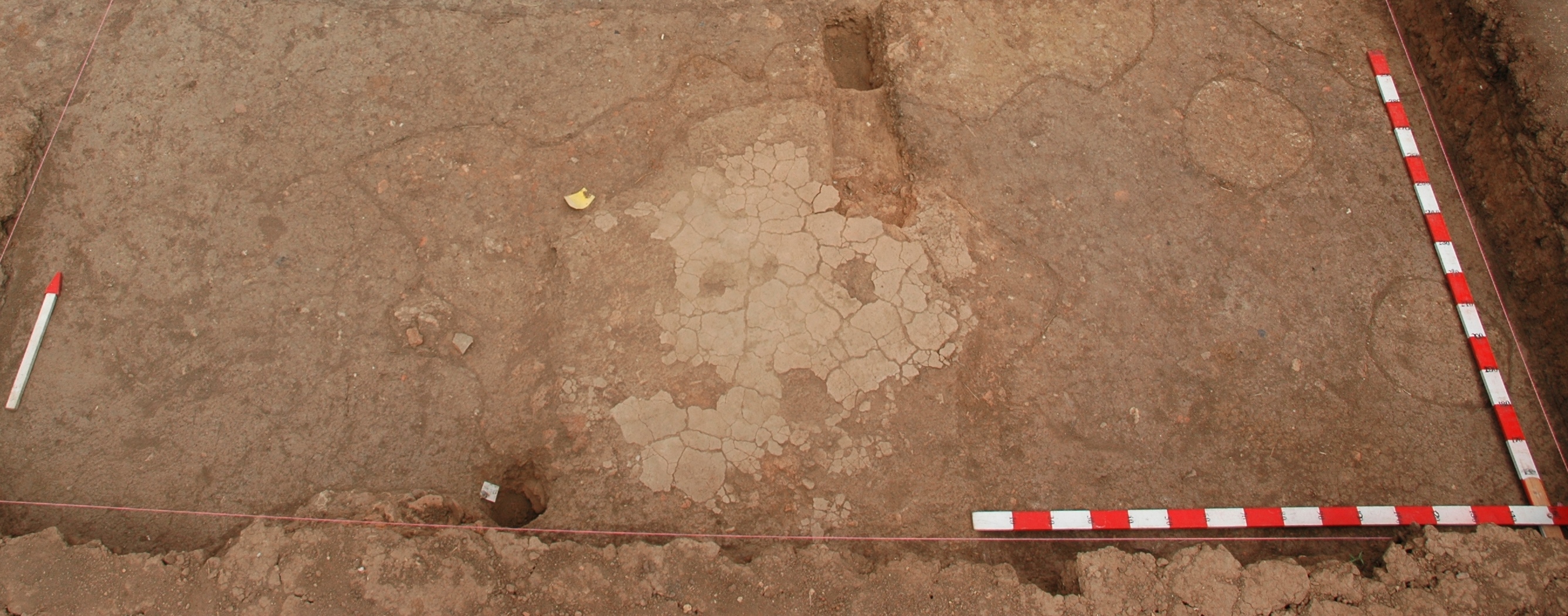Thermal Structures
Thermal structures at the Neolithic settlement of Avgi in Kastoria: a short introduction
One of the key research questions that contributed to the excavation planning at the Neolithic settlement of Avgi in Kastoria has been the functional understanding of the abundant and dispersed architectural material remains recorded on the site (Stratouli 2007; 2013). Thermal structures, like hearths and ovens, constitute a significant component of the material culture remains that came to light after excavation at the site. Nuanced examination of thermal structure assemblages at the Avgi Neolithic settlement became part of a Doctoral research project that was completed at the School of History, Archaeology and Religion in Cardiff University, Wales, UK. (Kalogiropoulou 2013).
Thermal structures constitute material remains that are recurrently identified in the context of Neolithic settlements in Northern Greece (Pappa 2008). These features were the result of dynamic procedures that include the conceptualisation of human needs, planning, construction and preservation (Galanidou 1997). The present study examines hearths and ovens on the local scale and seeks to unfold various micro-histories of Neolithic lifeways at the site of Avgi around daily consumption practices. This study presents the three categories of thermal structures identified at the site, based on their morphological characteristics and the macroscopical analysis of raw materials used, ovens, hearths and nondescript structures. Petrographic analyses are expected at a later stage of the study of thermal structures at Neolithic Avgi. Application of the thin section technique will challenge questions on petrology, provenance of raw material used, construction techniques, functional properties and pyrotechnology.
Thermal structures at the Neolithic settlement of Avgi, Kastoria, constitute a morphologically and structurally diverse assemblage. Twenty-five securely identified hearths and ovens have been unearthed during six excavation seasons from 2002 to 2008. From this assemblage eleven features are classified as ovens, thirteen as hearths and one structure is described as a nondescript feature. Overall fourteen thermal structures are identified in the habitation horizon of Avgi I and eleven are classified in Avgi II. Avgi III is a heavily eroded layer (as a result of extensive levelling works and cultivation in the 2000s), where no preserved thermal structure remains was found.
Fig. 1: Avgi II, Thermal Structure 3, oven type 1a.
Ovens and hearths at Neolithic Avgi are subdivided in two categories based on structural and functional differences. Ovens, in particular, are classified as type 1a and type 1b. Type 1a ovens are classified as structures with an uninterrupted, solid roofed compartment and front-loaded entrance (Fig. 1). These are circular and semicircular above ground, with subterranean features that average 0.70 m in length and 0.50 m in width. The main building material used was clay tempered with roughly powdered gravel and weak organic mixtures like straw. Pebbles were also used as part of oven floor settings, marking the production of elaborate and carefully constructed features (e.g. Servia: Ridley et al. 2000; Nea Nikomedeia: Wardle 1996). Type 1b ovens share common morphological characteristics with type 1a features, such as the roofed compartment and the front-loaded entrance. Major difference of type 1b ovens, however, is their perforated vault (Fig. 2). These are circular and semicircular subterranean structures average 0.60 m in length and 0.50 m in width. Construction materials used are in this case clay roughly tempered with gravel and with weak organic mixtures. At Neolithic Avgi, ovens hold no records of reconstruction works. Baking and roasting of food in small pots inside the ovens is likely, whereas grilling (direct heat) is also possible. Due to the small size of these structures boiling can only occur indirectly in baskets or skins (Atalay and Hastorf 2006). Parching is also common in Neolithic cooking practices and it is possible in case of Avgi Neolithic settlement.
Fig. 2: Avgi II, Thermal Structure 2, oven type 1b.
Hearths, on the other hand, are classified as type 2a and type 2b. The shape, size and functional properties of both type 2a and type 2b hearths indicate constructive and functional similarities and their classification into subcategories is only based on the raw materials used and the construction techniques applied. All hearths are above-the-ground features of circular or mainly of irregular shape with an average diameter of 1.00 m. More specifically, type 2a hearths are classified as those with river pebble settings and finely sieved with powdered temper inclusions clay floors that lack organic mixtures. The surface of the clay floor of hearths type 2a is smoothed or polished. In contrast, macroscopic examination of the material records of hearths type 2b demonstrate the construction of matt surfaces of roughly sieved clay floors. The floors of these features were built directly on top of the ground with no additional preparation such as the construction of clay basins or pebble setting. The clay used for the construction of these hearth floors was tempered with rich organic mixtures like straw (Fig. 3). Reconstruction works are occasionally recorded in both hearth categories. Cooking practices differ in the open-air fire conditions of hearths. Parching of grains and pulses is an expected cooking practice. Indirect boiling in baskets or skins and direct boiling using pots placed on top of fire is also likely. Grilling in direct heat and smoking of meat or fish is also possible. As opposed to ovens, however, cooking on a hearth requires more of the users’ attention in order to preserve fire and heat (Atalay and Hastorf 2006).
Fig. 3: Avgi I, Thermal Structure 17, hearth type 2b.
Finally, as nondescript type 3 structures are classified as the features relating to fire and cooking but lacking the morphological characteristics usually attributed to hearths and ovens. These structures are identified by thick concentration of ash as a result of repeated burning and by dense scatter of cooking and consumption practices residues such as organic remains and tools. Only one nondescript type 3 structure has to date been identified at the Avgi Neolithic settlement.
Based on available data to date all twenty-five thermal structures recorded at Neolithic Avgi were built in open-air spaces with direct or indirect association to buildings. The results of macroscopic analysis of in situ thermal structures recorded in Avgi I and II to date demonstrate that fire installations are missing from the inner areas of buildings. Lightening and heating inside the houses could be achieved by the use of portable furnitures like braziers. Spatial analysis shows that hearths and ovens are repeatedly related to the finds of various tool categories and especially with ground stone tools, demonstrating a direct association of food preparation spaces with cooking spaces. Thermal structures at Neolithic Avgi formed dynamic spaces of shared daily experiences and social interaction around cooking and consumption practices. Their spatial distribution in open-air spaces challenges the boundaries of the Neolithic household and suggests diversity of Neolithic lifeways.
Indicative Bibliography
Atalay, S. and Hastorf, C. 2006. Food, meals and daily activities: food habitus at Neolithic Çatalöyük. American Antiquity 71, 283–319.
Barrett, J. C. 2006. Archaeology as the investigation of the contexts of humanity. In D. Papaconstantinou (ed.), Deconstructing context. A critical approach to archaeological practice, 194–211. Oxford: Oxbow Books.
Byrd, B.F. 1994. Public and private, domestic and corporate: the emergence of the South Asian village. American Antiquity 14, 251–87.
Galanidou, N. 1997. ‘Home is where the hearth is’. The spatial organisation of the Upper Palaeolithic rockshelter occupations at Klithi and Kastritsa in northwest Greece. Oxford: BAR International Series 687.
Hodder, I. and Cessford, C. 2004. Daily practice and social memory at Çatalhöyük. American Antiquity 69, 17–40.
Kalogiropoulou, E. 2013. Cooking, space and the formation of social identities in Neolithic Northern Greece: evidence of thermal structure assemblages from Avgi and Dispilio in Kastoria. Unpublished Ph.D. Thesis: Cardiff University.
Kent, S. 1990. Activity areas and architecture: an interdisciplinary view of the relationship between use of space and domestic built environments. In S. Kent, Domestic architecture and the use of space, 1–8. Cambridge: Cambridge University Press.
Pappa, M. 2008. Organosi tou chorou kai oikistika stoicheia stous neolithikous oikismous tis Kentrikis Makedonias. D.E.Th.–Thermi–Makriyalos. Unpublished Ph.D. Dissertation: Aristoteleion University of Thessaloniki. (Spatial organisation and residential evidence at the Neolithic settlements of Central Macedonia: I.F.Th.–Thermi–Makriyalos).
Papadopoulou, E. and Prévost-Dermarkar, S. 2007. ‘Il n’y a pas de cuisine sans feu’. Une approche des techniques culinaires au Néolithique et à l’Âge du Bronze Ancien à travers les structures de combustion en Grèce du Nord. In C. Mee and J. Renard (eds), Cooking up the past. Food and culinary practices in the Neolithic and Bronze Age Aegean, 123–35. Oxford: Oxbow Books.
Ridley, C., Wardle, K.A. and Mould C.A. (eds.) 2000. Servia I. Anglo-Hellenic rescue excavations 1971–73 directed by Katerina Rhomiopoulou and Cressida Ridley. Supplementary Volume no. 32. Oxford: The British School at Athens.
Souvatzi, S. 2008. A social archaeology of households in Neolithic Greece: an anthropological approach. Cambridge: Cambridge University Press.
Stratouli, G. 2007. Neolithikos oikismos Avgi Kastorias 2006-2007: choro-organotikes praktikes 6is kai 5is hilietias. Archeologiko Ergo Makedonias kai Thrakis 21, 7–14. (Neolithic settlement Avgi Kastorias 2006–2007: spatial practices in the 6th and 5th millennia).
Stratouli, G. 2013. Neolithikos oikismos Avgi Kastorias: mia agrotiki koinonia se metavasi. Archaeology Online – New excavations in Neolithic Macedonia (Part D). www.archaiologia.gr/blog/2-13/10/07/νέες-ανασκαφικές-έρευνες-στη-νεολιθι-4/ (Neolithic settlement of Avgi in Kastoria: a rural community in transition).
Hourmouziadis, G.H. 1979. To neolithiko Dimini. Prospatheia gia mia nea prossegisi tou neolithicou ulikou. Volos: Etaireia Thessalikon Ereunon. (Neolithic Dimini: attempt for a new approach of the Neolithic material).
Wardle, K.A. (ed.) 1996. Nea Nikomedeia I: the excavation of an Early Neolithic village in Northern Greece 1961-1964. The excavation and the ceramic assemblage. Oxford: The British School at Athens. Supplementary Volume no. 25.
Whittle, A. 2003. The archaeology of people: dimensions of Neolithic life. London and New York: Routledge.
January 2014
Dr. Evita Kalogiropoulou
KalogiropoulouE@cardiff.ac.uk




